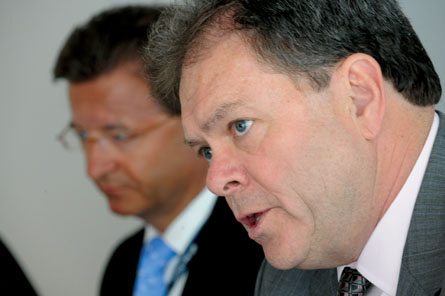German company MTU Aero Engines announced at ILA2008 yesterday that it is taking a 15% risk-sharing stake in two Pratt & Whitney (P&W) engines – the PW810 and the Geared Turbofan (GTF) - which share a common core. MTU is investing €30m this year in increased R&D spend.
The 10,000-lbs (45kN) thrust PW810 is targeted at the large business jet market (launch customer is Cessna, with its Citation Columbus) while the 15,000/17,000lbs (68/77kN) thrust GTF will feature on the Mitsubishi Regional Jet. However, if Bombardier launches its C-series regional aircraft at this year’s Farnborough Airshow as industry sources predict, the GTF will be the sole-source of power on that airframe too.
|
|---|
MTU is a long-established player in the aero engine industry, cooperating with the global OEMs - namely GE, P&W and Rolls-Royce. The company specialises in high-pressure compressors and low-pressure turbines – along with engine control units - and CEO Egon Behle, speaking at ILA2008, said that the deal with P&W had already been signed and that “we expect sales over the whole programme life to be valued at up to around €5bn to MTU for each model.”
Behle also said that the GTF would be ‘scaleable’ up to around 20,000lbs thrust, and that this engine could be very interesting to Airbus and Boeing, both of which have been talking about a 2015/2019 window for producing the next generation of narrow body commercial airliners.
MTU will develop, produce and assemble the low-pressure turbine, along with developing and producing the first four stages of the high-pressure compressor for both the PW810 and the GTF.
P&W’s senior VP of sales and marketing Robert Keady said: “We are excited to continue our long-term partnership with MTU as we work together to bring the next generation of commercial engines to market.”
He also said that the geared fan technology would enable both it, and the low-pressure section of the engine, to run at optimum speed, reducing the number of airfoils in each engine by 1,400 and thus reducing maintenance costs along with fuel costs as the engine is extremely fuel-efficient.
Egon Behle said that the GTFwould offer gains of around 15% in both fuel burn and emissions while further developments involving contra-rotating and heat-exchanger technology would gains of 5% and 10% respectively.
Development of the two engines is already underway – with EIS expected in 2013. The underlying technology, using a P6000 core, is being validated at P&W’s West Palm Beach facility in California and this, according to Keady, is going “flawlessly” over more than 250 hours of running with a flight-capable nacelle. He also said that at a recent symposium of 30 airline chiefs at West Palm Beach, the ‘suits’ had stood within 900ft of a GTF engine running at full power and had been able to chat normally with no ear protection. “Hearing is believing”, he concluded.
Flight testing of the GTF on P&W’s B747 flying testbed will begin this summer and Airbus has also announced that it will test a GTF demonstrator engine on the wing of a converted A340 towards the end of 2008.
*Keady and Behle also said that the two companies had recently signed an MOU to examine joint opportunities for future powerplants on potential European UAVs.
Visit the official Berlin Air Show site
Flight's ACAS Business Aviation
Flight's products including the Business Aircraft Pocket Guide
All the show news, pictures, blogs, and video.
All the news from ILA 2008
Source: Flight Daily News

















